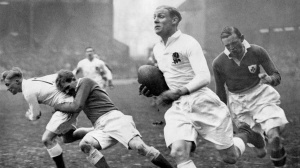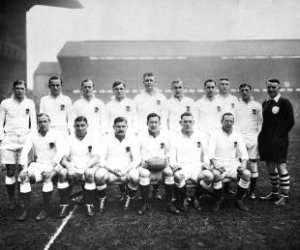
The great Peter Cranmer makes a break against Wales in 1935
International coaches – and selection panels before them – traditionally prize solidity at centre, and nowhere more than in England.
Which is not to say that they’ve not had great creative centres; Jeff Butterfield, Jerry Guscott and Will Greenwood had talents that would have been welcomed in any team in the world.
ESPNscrum
Each, though, had an accomplished straight man – calm, dependable and rocklike in defence – to balance their dash and imagination. Butterfield had Phil Davies, Guscott was complemented by Will Carling and Greenwood by Mike Tindall.
Peter Cranmer, who was born 100 years ago this month on September 10 1914, was a member in high standing of this line of solid English centres.
Wilf Wooller, who faced him in Varsity and international matches, recalled that his “attack presented little difficulty, but he was the most difficult defender to outwit whom I ever played against”.
Those talents were clearly appreciated by the England selectors of the 1930s. Cranmer was an ever-present for five seasons, from 1934 to 1938 – a span which could nowadays lead to something like 60 caps, but in an era when the southern giants visited once per decade and France’s expulsion meant there were only three home internationals per season left him with the slightly less imposing tally of 16.
It also created one of English rugby’s might-have-beens. The Waterloo and Lancashire pairing of Jack Heaton and Ray Leyland dazzled opponents and spectators with their brilliantly intuitive combination.
But they were paired only once for England – against Ireland in 1935, with Cranmer moved to the wing – and in spite of a 14-3 England win, the selectors showed no inclination to repeat the experiment.
Cranmer was, though, involved in English rugby’s greatest moment of brilliance that decade.
If the victory over the All Blacks is forever more, and rightly, Alexander Obolensky’s match, Cranmer played a vital supporting role.
On the morning of the match the Chairman of Selectors had told him “We want you to play left centre, not right centre, so the ball can get to Obolensky”.
Yet it was his break, supported by outside-half Peter Candler, that created the position from which Obolensky made his immortal angled left-to-right try-scoring dash. He also dropped the second-half goal which rounded off England’s 13-0 win and was hailed in one match report as “the best-all round player on the park. His centre play was probably the best seen at Twickenham for many years.
He hardly ever put a hand wrong”.
At 21, Cranmer was only 18 months older than England’s improbably exotic debutant, but already an experienced top-level player. His talent had been spotted while he was a pupil at St Edward School, Oxford – which he attended as a choral scholar – by RFU’s James ‘Bim’ Baxter.
Cranmer surmised that his subsequent offer of a place to study at Christ Church College, Oxford owed much to Baxter’s rating of him as a future international.
His implication that it owed little to classroom achievements is supported by the fact that he dropped out after only four terms, joining a stockbroking firm at Christmas 1934.
He had by then played in two Varsity matches – his break and kick ahead setting up the winning try in Oxford’s win in 1933 – and fulfilled Baxter’s prediction by winning his first England cap aged only 19 years and four months.
He was to remain ever after grateful to his more experienced centre partner Ronnie Gerrard of Bath who switched positions to cope with lethal Welsh centre Claude Davey for the first 20 minutes, recalling of their first clash that “two pieces of granite went into each other”.
One match report noted that he and Gerrard “looked after the England defence admirably” in England’s 9-0 win.
He was hailed as “a brilliant player in the making” and “a fair-haired picture star” type after a 13-3 defeat of Ireland took England two-thirds of the way to a Triple Crown completed with a 6-3 win over Scotland.

The England crop of 1936 prepare to face New Zealand.
There was another Triple Crown in 1937 and the England captaincy in 1938, a strangely high-scoring year amid the single figure tallies more characteristic of the age.
He was dropped after the 36-14 win in Dublin, admitting that “I hadn’t played well against Ireland”, but was reinstated for the Calcutta Cup after the player chosen to replace him was injured.
Under the leadership of hooker Bert Toft he had what he remembered as “an even worse match” against Scotland, who scored five tries in a 21-16 epic at Twickenham.
That was the end of his England career, although he did not know it at the time.
A formidable all-round sportsman, he had been playing county cricket for Warwickshire in 1934 and in 1938 was asked to become captain after former England captain Bob Wyatt was sacked from the job.
Cranmer recalled that “I never had a more embarrassing nor difficult time” than during the row which accompanied Wyatt’s removal.
So he was unavailable to take up an invitation to go with the Lions to South Africa in 1938.
The following season he played in the England trials, but was injured playing for North Midlands. Selector John Daniell urged him to get fit because “we are hoping you will be able to play full-back this season”.
A cartilage operation ended such hopes for the last peacetime season. Cranmer went on to play in two early wartime internationals and like Wooller had his final top-level fling in early 1940 in Paris as a member of the British Forces team which beat France 36-3.
As also with Wooller, cricket – where his formidable hitting and unreliable defence inverted his rugby attributes – lasted longer.
After rising to Major during war service which included two years in Burma, Cranmer returned to lead Warwickshire through the first two peacetime seasons and – in a remarkable coda to his cricket career, led their 2nd XI in the late 1960s and early 1970s.
His charges in his last season, aged 57, included the future England bowlers Eddie Hemmings and Bob Willis.
There was also a second career as a sports journalist and broadcaster, recalled by cricket commentary legend Brian Johnson as “completely natural, almost conversational” when he appeared on ‘Test Match Special’, but a little less accomplished at duller disciplines like timekeeping.
His Wisden obituary recalls his later decades, following a stroke in 1976, as “cruel”.
Having to have his legs amputated brought out the black humourist in him as he spoke of “getting legless again”. He died in May 1994.
He can be seen, briefly, on film at the beginning of the Obolensky try, lives on in the memory of the middle-aged as a radio voice of our childhood and is firmly ingrained in the spirit and practice of English rugby as the epitome of that invaluable but often underrated chap, the solid centre.